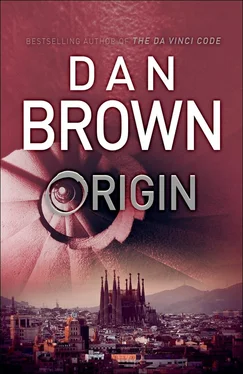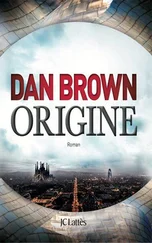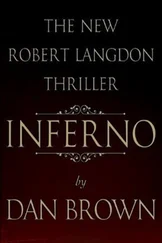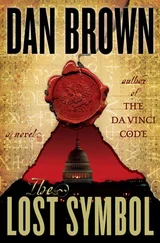“The notation on the back of this title card,” Langdon interjected, holding it up, “says that the Blake book must be displayed in a particular way — lying open to page one hundred and sixty-three?”
“Yes, that’s correct.”
Langdon felt his pulse quicken. “Can you tell me which poem is on that page?”
Beña shook his head. “There is no poem on that page.”
“I’m sorry?!”
“The book is Blake’s complete works — his artwork and writings. Page one sixty-three is an illustration.”
Langdon shot an uneasy glance at Ambra. We need a forty-seven-letter line of poetry — not an illustration!
“Father,” Ambra said to Beña. “Would it be possible for us to see it right away?”
The priest wavered an instant, but apparently thought better of refusing the future queen. “The crypt is this way,” he said, leading them down the transept toward the center of the church. The two Guardia agents followed behind.
“I must admit,” Beña said, “I was hesitant to accept money from so outspoken an atheist, but his request to display his mother’s favorite Blake illustration seemed harmless to me — especially considering it was an image of God.”
Langdon thought he had misheard. “Did you say Edmond asked you to display an image of God ?”
Beña nodded. “I sensed he was ill and that perhaps this was his way of trying to make amends for a life of opposition to the divine.” He paused, shaking his head. “Although, after seeing his presentation tonight, I must admit, I don’t know what to think.”
Langdon tried to imagine which of Blake’s countless illustrations of God Edmond might have wanted displayed.
As they all moved into the main sanctuary, Langdon felt as if he were seeing this space for the very first time. Despite having visited Sagrada Família many times in various stages of its construction, he had always come during the day, when the Spanish sun poured through the stained glass, creating dazzling bursts of color and drawing the eye upward, ever upward, into a seemingly weightless canopy of vaults.
At night, this is a heavier world.
The basilica’s sun-dappled forest of trees was gone, transformed into a midnight jungle of shadows and darkness — a gloomy stand of striated columns stretching skyward into an ominous void.
“Watch your step,” the priest said. “We save money where we can.” Lighting these massive European churches, Langdon knew, cost a small fortune, and yet the sparse utility lighting here barely illuminated the way. One of the challenges of a sixty-thousand-square-foot floor plan.
As they reached the central nave and turned left, Langdon gazed at the elevated ceremonial platform ahead. The altar was an ultramodern minimalistic table framed by two glistening clusters of organ pipes. Fifteen feet above the altar hung the church’s extraordinary baldachin — a suspended cloth ceiling or “canopy of state” — a symbol of reverence inspired by the ceremonial canopies once held up on poles to provide shade for kings.
Most baldachins were now solid architectural features, but Sagrada Família had opted for cloth, in this case an umbrella-shaped canopy that seemed to hover magically in the air above the altar. Beneath the cloth, suspended by wires like a paratrooper, was the figure of Jesus on the cross.
Parachuting Jesus , Langdon had heard it called. Seeing it again, he was not surprised it had become one of the church’s most controversial details.
As Beña guided them into increasing darkness, Langdon was having trouble seeing anything at all. Díaz pulled out a penlight and lit the tile floor beneath everyone’s feet. Pressing on toward the crypt entrance, Langdon now perceived above him the pale silhouette of a towering cylinder that climbed hundreds of feet up the interior wall of the church.
The infamous Sagrada spiral , he realized, having never dared ascend it.
Sagrada Família’s dizzying shaft of circling stairs had appeared on National Geographic ’s list of “The 20 Deadliest Staircases in the World,” earning a spot as number three, just behind the precarious steps up the Angkor Wat Temple in Cambodia and the mossy cliffside stones of the Devil’s Cauldron waterfall in Ecuador.
Langdon eyed the first few steps of the staircase, which corkscrewed upward and disappeared into blackness.
“The crypt entrance is just ahead,” Beña said, motioning past the stairs toward a darkened void to the left of the altar. As they pressed onward, Langdon spotted a faint golden glow that seemed to emanate from a hole in the floor.
The crypt.
The group arrived at the mouth of an elegant, gently curving staircase.
“Gentlemen,” Ambra said to her guards. “Both of you stay here. We’ll be back up shortly.”
Fonseca looked displeased but said nothing.
Then Ambra, Father Beña, and Langdon began their descent toward the light.
Agent Díaz felt grateful for the moment of peace as he watched the three figures disappear down the winding staircase. The growing tension between Ambra Vidal and Agent Fonseca was becoming worrisome.
Guardia agents are not accustomed to threats of dismissal from those they protect — only from Commander Garza.
Díaz still felt baffled by Garza’s arrest. Strangely, Fonseca had declined to share with him precisely who had issued the arrest order or initiated the false kidnapping story.
“The situation is complex,” Fonseca had said. “And for your own protection, it’s better you don’t know.”
So who was issuing orders? Díaz wondered. Was it the prince? It seemed doubtful that Julián would risk Ambra’s safety by spreading a bogus kidnapping story. Was it Valdespino? Díaz wasn’t sure if the bishop had that kind of leverage.
“I’ll be back shortly,” Fonseca grunted, and headed off, saying he needed to find a restroom. As Fonseca slipped into the darkness, Díaz saw him take out his phone, place a call, and commence a quiet conversation.
Díaz waited alone in the abyss of the sanctuary, feeling less and less comfortable with Fonseca’s secretive behavior.
The staircase to the crypt spiraled down three stories into the earth, bending in a wide and graceful arc, before depositing Langdon, Ambra, and Father Beña in the subterranean chamber.
One of Europe’s largest crypts , Langdon thought, admiring the vast, circular space. Exactly as he recalled, Sagrada Família’s underground mausoleum had a soaring rotunda and housed pews for hundreds of worshippers. Golden oil lanterns placed at intervals around the circumference of the room illuminated an inlaid mosaic floor of twisting vines, roots, branches, leaves, and other imagery from nature.
A crypt was literally a “hidden” space, and Langdon found it nearly inconceivable that Gaudí had successfully concealed a room this large beneath the church. This was nothing like Gaudí’s playful “leaning crypt” in Colònia Güell; this space was an austere neo-Gothic chamber with leafed columns, pointed arches, and embellished vaults. The air was deathly still and smelled faintly of incense.
At the foot of the stairs, a deep recess stretched to the left. Its pale sandstone floor supported an unassuming gray slab, laid horizontally, surrounded by lanterns.
The man himself , Langdon realized, reading the inscription.
ANTONIUS GAUDÍ
As Langdon scanned Gaudí’s place of rest, he again felt the sharp loss of Edmond. He raised his eyes to the statue of the Virgin Mary above the tomb, whose plinth bore an unfamiliar symbol.
What in the world?
Читать дальше










